Special Hobby's 1/72 Lockheed Model L-12 | | History Following upon the success of their 1934 ten passenger Model L-10 Electra airliner, Lockheed, in 1936, designed a smaller very similar airplane, the six passenger Model L-12. This was intended to be a feeder to the larger airliners and a private plane for businesses and the rich and famous - sort of a pre-war Learjet. 130 L-12s, and the military derivative, L-212 were built. The great majority went to individuals and to various militaries; 33 to the Netherlands, 12 to Brazil, 12 to Argentina and 10 to the USAAC; very few went to airlines. Production ended in 1942 when Lockheed geared up for serious production of military airplanes. About 30 L-12s are still flying. No single L-12 stands out as boldly in history as one of its big sisters, the L-10 flown into fame and oblivion by Amelia Earhart. The best-known L-12, perhaps, was "The Texan", NR869E, bought by Benedum Trees Oil Company for adventurer Jimmy Mattern to use in the 1937 New York-to-Paris Air Derby. The plane was even outfitted for in-flight refueling from a Ford Trimotor tanker. In the event, the Derby was canceled in and, in August 1937, Jimmy went adventuring north to attempt a record trans-polar flight to Russia. This flight was aborted so that Jimmy could help in the search for Russian aviator Sigismund Levanevsky, the "Lindbergh of Russia" and his crew lost on their own trans polar Russia-to-USA record attempt. A couple of years earlier Levanevsky had rescued Jimmy when his Vega crashed in Siberia ending Jimmy's solo circumnavigation attempt. Levanevsky was not found and "The Texan" returned home to be converted into a plush VIP plane for Benedum's subsidiary Republic Oil Company and was flown by Jimmy until he joined Lockheed as a Production Flight Test pilot. Aussie Sidney Cotton, too, brought some fame to the L-12 with his use of two as pre-war/early war "Spy Planes". He flew L-12A, c/n1267, G-AFKR, for British and French Intelligence work from January to May of 1939 and c/n 1203, G-AFTL, from May of 1939 until it was sold by British Overseas Airways Corporation to one of its subsidiaries. Post war Cotton personally acquired G-AGTL, which he operated until 1956. The first two planes were registered to B.O.A.C. as cover for their military use. Specifications Comparison: | Lockheed L-10 | Lockheed L-12 | Span | 55' | 49'6" | Length | 38'7" | 36'4" | Max. Speed | 202 MPH | 225 MPH | Service Ceiling | 20,000' | 23,000' | Normal Range | 810 Miles | 800 Miles | Engine options | P & W R-985
P & W R-1340
Wright R-975 | P & W R-985
Wright R-975 | Nominal MGTOW | 10,000 pounds | 8,400 pounds | Although commonly called, for obvious reasons, "Electra Junior", "Junior Electra" and "Baby Electra", many old timers aver these names were not applied to the L-12 until after the war. 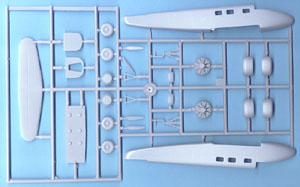 The Kit The Kit
Two sprue trees contain 46 injection-molded parts in light gray styrene. Accompanying these basic parts are six cabin windows injection molded in clear styrene, two configurations of vac-formed windscreens cum cabin tops and 13 detail parts in resin and a decal sheet. The 12 page instruction pamphlet provides a brief history in four languages, a parts map, 11 steps of wordless assembly instructions and four color/markings schemes. The sharply printed, in perfect register, decal sheet by Cartograf provides markings for the four optional color schemes set out in the instructions: one in RAF Brown/Green over yellow, a US Naval Attache plane in the same scheme and two of Sidney Cotton's B.O.A.C. planes, G-AFTR and G-AFTL in, according to the instructions sheet, RAF "Camoutint" pale green with civil markings in a medium gray-green. While it is quite likely that Cotton's G-AFKR, not shown in the kit as a markings option, and G-AFTL were painted in the RAF's pale green "Camoutint", I 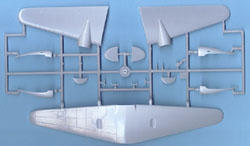 seriously doubt that his post war G-AGTL was also so painted as the instruction sheet would have us believe. I also suspect that the post war G-AGTL's markings were in B.O.A.C. dark blue on unpainted bare metal. Can any reader comment helpfully on this? I think I'll avoid all this speculation and do my L-12 in the well-documented markings of Jack Frye's TWA high altitude/weather research plane, NC18137 with plain red TWA markings on a bare metal finish. Another nice livery to use would be Gulf Oil's VIP transport in bare metal with orange and blue markings. The decal sheet gives us way more Lockheed logos than we need for one airplane (good for the old spares box), but does not give us Hamilton-Standard prop logos or prop blade data blocks. seriously doubt that his post war G-AGTL was also so painted as the instruction sheet would have us believe. I also suspect that the post war G-AGTL's markings were in B.O.A.C. dark blue on unpainted bare metal. Can any reader comment helpfully on this? I think I'll avoid all this speculation and do my L-12 in the well-documented markings of Jack Frye's TWA high altitude/weather research plane, NC18137 with plain red TWA markings on a bare metal finish. Another nice livery to use would be Gulf Oil's VIP transport in bare metal with orange and blue markings. The decal sheet gives us way more Lockheed logos than we need for one airplane (good for the old spares box), but does not give us Hamilton-Standard prop logos or prop blade data blocks. 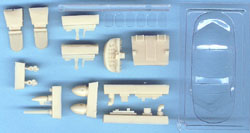 All the parts are cleanly and crisply molded with no sink marks and only a tiny bit of unobtrusive flash on a few of the smallest parts. The resin parts are clean, sharp and bubble-free and include optional propeller spinners. Interestingly, the main cabin floor molding has bases for six passenger seats, but the kit provides no seats! Similarly, Special Hobby's earlier kit of the L-10 Electra has a clean cabin floor and no seats. This really does not matter as you won't be able to see much inside either model anyway. So just paint the cabin interior flat black and fit tied-back airliner-style curtains to the inside front and rear of each cabin window to further reduce the size of the viewing port. Sneaky, eh? The Kit engineering assures a simple, fairly quick, build with no tricky areas. Being a confirmed AMSer I do, however, have a few nitpicks: All the parts are cleanly and crisply molded with no sink marks and only a tiny bit of unobtrusive flash on a few of the smallest parts. The resin parts are clean, sharp and bubble-free and include optional propeller spinners. Interestingly, the main cabin floor molding has bases for six passenger seats, but the kit provides no seats! Similarly, Special Hobby's earlier kit of the L-10 Electra has a clean cabin floor and no seats. This really does not matter as you won't be able to see much inside either model anyway. So just paint the cabin interior flat black and fit tied-back airliner-style curtains to the inside front and rear of each cabin window to further reduce the size of the viewing port. Sneaky, eh? The Kit engineering assures a simple, fairly quick, build with no tricky areas. Being a confirmed AMSer I do, however, have a few nitpicks:
1. There are no running lights. These took the form of small half-teardrop shapes on the wing tips and a pointed round lens at the aft most point of the fuselage just below the elevator. 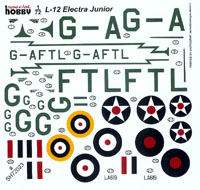 2. There is no trailing antenna lead out. This was a small tube just below therear running light. On the ground the drag weight would be pulled up tightly against the tube, so add a small rounded shape to the end of the tube. 2. There is no trailing antenna lead out. This was a small tube just below therear running light. On the ground the drag weight would be pulled up tightly against the tube, so add a small rounded shape to the end of the tube.
3. There is no landing light on the nose. Get a clear MV Lens of ~3/32" diameter and mount it in a shallow depression drilled in the dead center of the nose of the fuselage. Other than these few small points there is nothing of note that needs correcting on this kit. It does not need to be "Scratchbuilt-out-of-the-box". Conclusion Another very nice rare bird from Special Hobby. Now we need an L-14 Super Electra and an L-18 Lodestar to complete the Lockheed family of pre-war civil twins. And while they are at it, I hope Special Hobby will complete the Lockheed family of pre-war civil singles that they started with their Orion by giving us: the Vega in several optional configurations, the Speed Vega, the Air Express, the Explorer, the Sirius and the Altair. Come on Special Hobby, how about it? Am I being greedy? Thank you Special Hobby; keep 'em coming. References: 1. Lockheed Aircraft Since 1913: Rene J. Francillon, Naval Institute Press, Annapolis, 1987, ISBN: 0-87021-897-2 2. Wings or Airpower magazine: 1970s?* Article "Electra, The Twin Tailed Lockheeds" by C.M. Daniels 3. Model Art Magazine: 1970s?* L-12 cutaway drawing 4. Flight magazine: Pre war* L-12 cutaway drawing 5. Invaluable oral assistance from John Alcorn, John Amendola and, our editor, Chris Banyai-Riepl * Issues and dates not recorded - sorry 'bout that. | 


 



  
    |
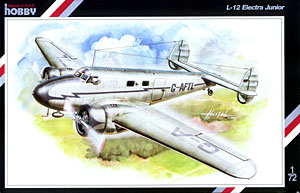
 The Kit
The Kit seriously doubt that his post war G-AGTL was also so painted as the instruction sheet would have us believe. I also suspect that the post war G-AGTL's markings were in B.O.A.C. dark blue on unpainted bare metal. Can any reader comment helpfully on this? I think I'll avoid all this speculation and do my L-12 in the well-documented markings of Jack Frye's TWA high altitude/weather research plane, NC18137 with plain red TWA markings on a bare metal finish. Another nice livery to use would be Gulf Oil's VIP transport in bare metal with orange and blue markings. The decal sheet gives us way more Lockheed logos than we need for one airplane (good for the old spares box), but does not give us Hamilton-Standard prop logos or prop blade data blocks.
seriously doubt that his post war G-AGTL was also so painted as the instruction sheet would have us believe. I also suspect that the post war G-AGTL's markings were in B.O.A.C. dark blue on unpainted bare metal. Can any reader comment helpfully on this? I think I'll avoid all this speculation and do my L-12 in the well-documented markings of Jack Frye's TWA high altitude/weather research plane, NC18137 with plain red TWA markings on a bare metal finish. Another nice livery to use would be Gulf Oil's VIP transport in bare metal with orange and blue markings. The decal sheet gives us way more Lockheed logos than we need for one airplane (good for the old spares box), but does not give us Hamilton-Standard prop logos or prop blade data blocks. All the parts are cleanly and crisply molded with no sink marks and only a tiny bit of unobtrusive flash on a few of the smallest parts. The resin parts are clean, sharp and bubble-free and include optional propeller spinners. Interestingly, the main cabin floor molding has bases for six passenger seats, but the kit provides no seats! Similarly, Special Hobby's earlier kit of the L-10 Electra has a clean cabin floor and no seats. This really does not matter as you won't be able to see much inside either model anyway. So just paint the cabin interior flat black and fit tied-back airliner-style curtains to the inside front and rear of each cabin window to further reduce the size of the viewing port. Sneaky, eh? The Kit engineering assures a simple, fairly quick, build with no tricky areas. Being a confirmed AMSer I do, however, have a few nitpicks:
All the parts are cleanly and crisply molded with no sink marks and only a tiny bit of unobtrusive flash on a few of the smallest parts. The resin parts are clean, sharp and bubble-free and include optional propeller spinners. Interestingly, the main cabin floor molding has bases for six passenger seats, but the kit provides no seats! Similarly, Special Hobby's earlier kit of the L-10 Electra has a clean cabin floor and no seats. This really does not matter as you won't be able to see much inside either model anyway. So just paint the cabin interior flat black and fit tied-back airliner-style curtains to the inside front and rear of each cabin window to further reduce the size of the viewing port. Sneaky, eh? The Kit engineering assures a simple, fairly quick, build with no tricky areas. Being a confirmed AMSer I do, however, have a few nitpicks: 2. There is no trailing antenna lead out. This was a small tube just below therear running light. On the ground the drag weight would be pulled up tightly against the tube, so add a small rounded shape to the end of the tube.
2. There is no trailing antenna lead out. This was a small tube just below therear running light. On the ground the drag weight would be pulled up tightly against the tube, so add a small rounded shape to the end of the tube.






